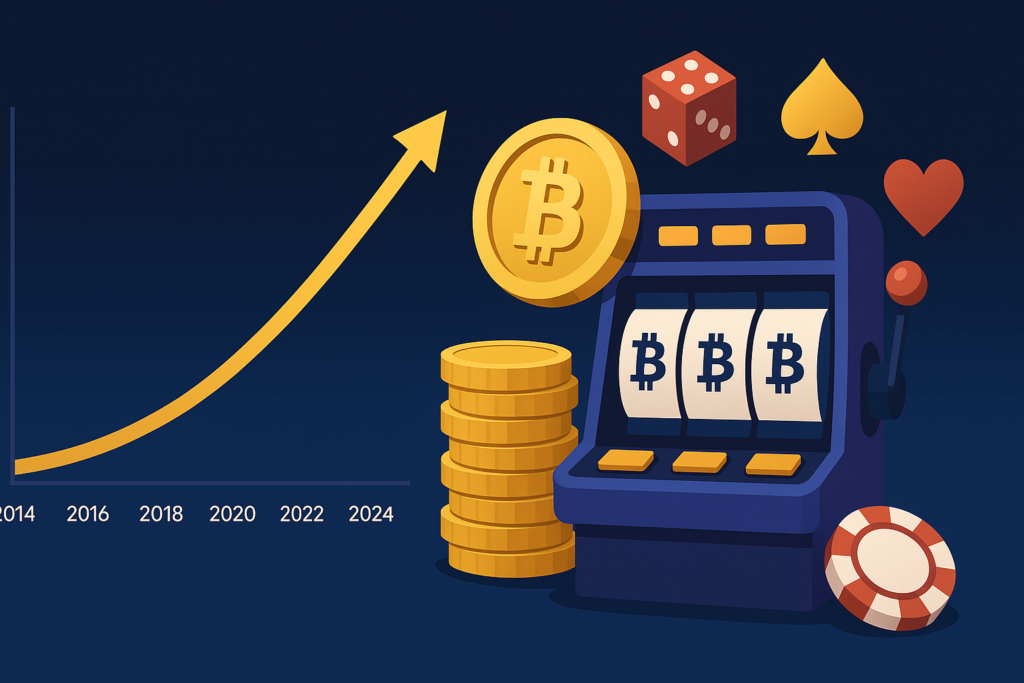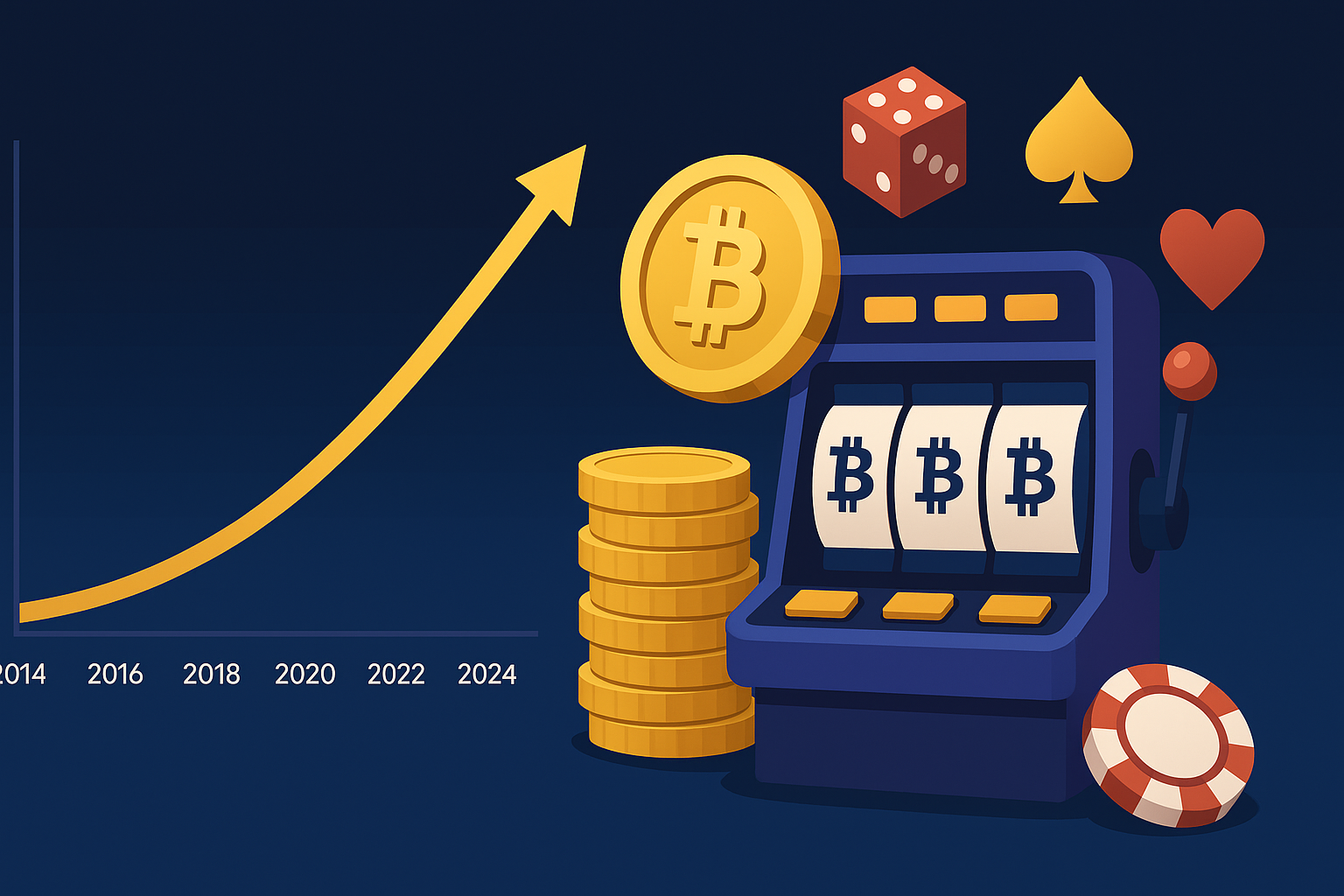
In recent years, crypto casinos have transformed from obscure curiosities into major pillars of the online gambling world. But that rise didn’t happen overnight. The journey involves a mix of crypto evolution, regulatory shifts, tech innovation, and cultural timing. In this article, I trace when crypto casinos began gaining traction, highlight key turning points, share lesser-known data, and give my take on why the real explosion happened when it did.
The Origins: From Bitcoin’s Birth to the First Bets
To understand when crypto casinos “took off,” we need to look back to the early days of Bitcoin itself. Bitcoin launched in 2009, but for several years it was used mainly by tech hobbyists and privacy advocates. It wasn’t until 2012 that the first major crypto gambling experiment appeared — a site called SatoshiDice.
SatoshiDice allowed players to bet directly through Bitcoin transactions, and within months it was handling more Bitcoin volume than many exchanges. It introduced the idea of transparent, blockchain-verified outcomes and sparked dozens of imitators. Around that time, simple dice-based and slot-style Bitcoin casinos started to appear.
Still, crypto gambling was a niche pursuit. Between 2012 and 2015, only a small subset of crypto users even knew these sites existed, and the average player experience was crude by today’s standards — basic interfaces, limited games, and high risks.
The Slow Burn: 2013–2016
After the novelty of the first Bitcoin gambling experiments, growth slowed but the foundations of the modern crypto casino industry began forming. This was when the idea of “provably fair” algorithms gained traction — a cryptographic way for players to verify that outcomes weren’t manipulated.
Casinos began accepting multiple cryptocurrencies, not just Bitcoin. Litecoin and Dogecoin became early alternatives for players looking for faster transactions or cheaper fees. The industry also saw the first efforts at building brand trust and reputation through transparency and public audits.
However, the scene remained underground. There were few full-fledged casino experiences — most sites offered only one or two game types, often without customer support or proper licensing. The infrastructure simply wasn’t there yet.
The Inflection Point: 2017–2021
The true turning point came between 2017 and 2021. The crypto bull run of 2017 brought millions of new users into the ecosystem. Suddenly, crypto wasn’t just for coders and libertarians — it was a cultural phenomenon.
Crypto casinos began capitalizing on this wave by improving product quality. They added real casino lobbies, full game suites, and mobile-first designs that felt as polished as traditional iGaming sites. Blockchain technology improved transaction speed, and wallets became easier to use.
At the same time, regulations lagged behind. Many operators discovered that accepting crypto allowed them to bypass conventional banking hurdles, operate globally, and reduce player verification requirements. This freedom attracted both players and affiliates in droves.
By 2019, flagship platforms like Stake emerged, merging crypto gambling with full sportsbooks and VIP programs. Streamers and influencers began promoting these sites on Twitch and YouTube, normalizing crypto gambling to a mainstream audience.
By 2020–2021, crypto casinos had crossed a threshold: no longer a niche experiment, but a legitimate, fast-growing corner of online gaming.
The Popularity Surge: 2022–2024
If you ask me when crypto casinos truly became popular — the period when they moved from insider trend to mass attention — the answer is 2022 through 2024.
During this time, multiple industry reports estimated crypto gambling revenues reaching tens of billions annually. It’s estimated that total gross gaming revenue from crypto casinos surpassed $80 billion in 2024, up more than fivefold from 2022.
Stablecoins also changed everything. For the first time, players could gamble using crypto without worrying about volatility. Add faster on-chain networks, easier mobile wallets, and global streaming visibility, and the growth made perfect sense.
Crypto casinos also became a hot topic for regulators, as enforcement agencies realized that many users in banned jurisdictions were accessing them via VPNs. In a sense, that controversy only fueled more publicity.
By 2023, crypto casinos were everywhere — in affiliate marketing circles, social media streams, Telegram groups, and even mainstream publications. That’s the year I’d mark as the real “boom.”
Unique Data Points and Observations
One underappreciated detail about early crypto casinos is how much blockchain transaction volume they generated. At times, platforms like SatoshiDice processed more individual Bitcoin transactions than many small exchanges combined. Gambling remains one of the most transaction-dense use cases in crypto.
Another interesting trend is how many users first interacted with crypto through gambling rather than trading. For a large subset of the population, crypto casinos were their first wallet experience. Operators leveraged this by offering faucet-based demos, where players could test games for free before depositing.
Marketing also played a huge role. In the 2020s, influencer-driven gambling streams became massive traffic drivers, outperforming traditional ads. Many mid-tier crypto casinos claim that up to 80% of their sign-ups come through affiliate networks.
Finally, geography tells a fascinating story. Adoption was highest in countries where traditional online gambling is restricted — the U.S., the U.K., and parts of Asia. Crypto casinos became the de facto way for players in those markets to bypass restrictions, using crypto as both currency and access key.
Why 2022–2024 and Not Earlier?
Crypto gambling didn’t go mainstream sooner for several reasons. Before 2020, most crypto users treated their holdings as investments rather than spending money. Wallet UX was clunky, fees were high, and volatility was a deal-breaker for casual gaming.
Only once stablecoins, mobile wallets, and instant off-ramps became normal did it make sense for the average player to use crypto casually. Combine that with more reliable brands and influencer validation, and the ecosystem finally reached its breakout moment.
My Take: The True “Popular Year”
While crypto casinos technically existed since 2012, they didn’t become popular until 2023. That’s when the conversation shifted from “What’s a crypto casino?” to “Which crypto casino pays fastest?” It marked a cultural normalization of gambling with crypto — not just a technological novelty.
Looking Ahead
The industry’s future will depend on how it adapts to regulation, KYC expectations, and global compliance standards. Some operators are already seeking licenses under progressive jurisdictions, while others double down on anonymity and offshore status.
Regardless, the trend is irreversible. Crypto casinos have become a defining feature of both modern iGaming and the broader crypto economy. As with early internet poker in the 2000s, we’re witnessing the birth of a permanent category — one that will continue to evolve long after the hype cycles fade.
Conclusion
Crypto casinos began in 2012 with Bitcoin dice games but stayed niche for almost a decade. The real explosion came during the crypto bull runs of 2021–2023, when stablecoins, influencer marketing, and global accessibility collided.
If 2012 was the invention, and 2017 was the prototype, then 2023 was the year crypto casinos truly became popular — and 2024 confirmed they’re here to stay.
References
- www.casinowhizz.com/bitcoin-casinos/
- https://www.gamblinginsider.com/trafficology/212/global-rise-of-crypto-casinos
- https://www.ft.com/content/66f879c6-e51c-4e9d-91ba-b15eecac45c1
- https://blockonomi.com/crypto-gambling-stats/






